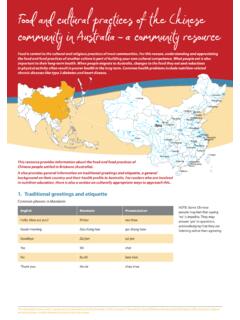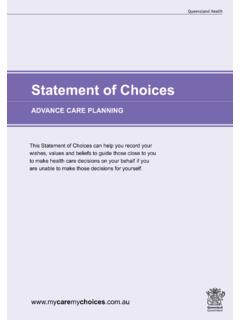Transcription of Afghan food and cultural profile: dietetic
1 This information is to be used as a guide and is not intended to describe all members of the community. There will be cultural differences between people belonging to different regions, religions and social groups, as well as between individuals within any Booking a client appointmentKey considerations Interpreters Enquire whether the client would feel more comfortable at the appointment if an interpreter were present. Be sure to confirm the client s preferred language, as there are more than 30 languages spoken in Afghanistan. The three most common languages spoken by Afghan people in Australia are Dari, Pashtun and Farsi. Encourage the family member who is responsible for the acquisition and preparation of food at home to attend appointments.
2 This is usually the responsibility of the adult women in the household. Afghan women may prefer to see a female dietitian, but the gender of the health professional is unlikely to be an issue for Afghan Preparation for the consultationWorking with an interpreterIt is important that a trained and registered interpreter be used when required. The use of children, other family members or friends is not advisable. Health services must consider the potential legal consequences of adverse outcomes when using unaccredited people to interpret if an accredited interpreter is available. If you have limited experience working with an interpreter, it is recommended that you improve these skills prior to the appointment. There are many online orientation courses available, and Queensland Health has produced guidelines for working with interpreters, which can be accessed resource is a guide for dietitian/nutritionists to provide culturally appropriate and effective services to Afghan community members.
3 It follows the ADIME format and provides information about the food and food practices of people from Afghanistan who have settled in Brisbane (Australia). The profile follows the chronological steps in individual case management. These include: 1. Booking a client appointment 2. Preparation for the consultation 3. Assessment 4. Diagnosis 5. Intervention 6. Monitoring and evaluationAfghan food and cultural profile: dietetic consultation guide AFGHANISTANKABULJ alalabadMayda ShahrAsadabadMahmud-EEraqiMehtar LamCharikarBamianPol-e-KhomriAybakFeyzab adTaloqanKondozBaraki BarakGardizGhazniZareh SharanQalatKandaharTarin KowtMazar-e-SharifBalkhSheberghanMeymane hQal eh-ye NowHeratFarahZaranjLashkar GahChaghcharanAndkhvoyThis information is to be used as a guide and is not intended to describe all members of the community.
4 There will be cultural differences between people belonging to different regions, religions and social groups, as well as between individuals within any food and cultural proflle: dietetic consultation guideTraditional greetings and etiquette Making contact such as shaking hands and kissing is appropriate between those of the same gender. Approach older Afghans with respect and be formal; for example, stand up to greet them. Younger people may expect a less formal approach. Salam or Salam alaikum means peace be unto you . These are suitable greetings for everyone. Hello is also appropriate. Verbal greetings may also be delivered with the hand over the heart, which is a sign of respect. Do not initiate discussions regarding family matters, religion, politics or the conflict in Afghanistan, as this may be considered are you?
5 Tsenga yeeChutoor hastaShoma chetur hastinThank youTashakor mananaTashakorMamnoonGoodbyeTer bia ledoloKhoda hafezKhoda hafezBackgroundReligionIslam is the official religion of Afghanistan, with 84% of the population being Sunni Muslims, 15% Shi ite Muslims, and the remaining 1% or fewer do not practice any religion1. In Australia, of people from Afghanistan identify Islam as their is made up of various ethnic groups, with the two largest groups being the Pashtuns (ethnic Afghans) and the Tajiks1. There are also the Uzbek and Hazara people. In Australia, of people from Afghanistan identify as Pashtuns and are official languages of Afghanistan are Pashto, the language of the Pashtun people, and Dari the language of the Tajik people.
6 Farsi (which is the official language of Iran) is also commonly spoken in the Afghan community. However, it is estimated that there are more than 30 unofficial languages spoken within Afghanistan1. In Australia, of people born in Afghanistan speak Dari, followed by Hazaraghi ( ) 2. History of conflict3 Lands controlled by the Pashtuns were united in 1747 and are considered to be the precursor to Afghanistan, but it was not until the 1880s that the area was named Afghanistan. Between 1839 and 1919, three wars were fought with Great Britain. A peace treaty was later signed in 1919, recognising Afghanistan as an independent state. There was a communist coup in 1978 and a Soviet invasion in 1979. The ensuing war ended in 1989, but civil war endured until 1992.
7 By 1996, the Taliban had risen to power and enforced strict Sharia (Islamic) laws that oppressed the rights of women. US and British forces began bombing Al-Qaeda targets in Afghanistan in response to the September 11, 2001 terrorist attacks in the USA. The Taliban were overthrown in December 2001, and the war left Afghanistan s economy and infrastructure in ruins. In recent times, the Taliban insurgency has continued in Afghanistan, including the persecution of minority groups, leading to unrest and civilian historyThe first cohort of Afghan people arrived in Australia during the 1860s and was employed as cameleers to explore the interior of the They established a successful camel transportation business, and the cameleers path subsequently became the train line named The Ghan that now runs into central Australia.
8 Currently, most Afghan migrants enter Australia through the Humanitarian Program. They have sought sanctuary in many countries since 1979 due to the continued civil war, the rise of the Taliban and invasion by the Soviet Union. Before arriving in Australia, they often flee to Pakistan and rolesTraditionally, Afghan male and female roles are divided clearly. Men are responsible for the public sphere (outside the home), while women are responsible for the domestic sphere (inside the home), including food preparation. In Australia, however, gender roles may vary between information is to be used as a guide and is not intended to describe all members of the community. There will be cultural differences between people belonging to different regions, religions and social groups, as well as between individuals within any food and cultural proflle: dietetic consultation guideHousehold sizeIn Afghanistan, the average size of a household is Traditionally, a household consists of a husband and wife, the sons with their spouses and children, and the unmarried daughters.
9 In Brisbane, the common Afghan household size is six to seven people. There are also some families with two to three in AustraliaAccording to the Department of Immigration and Citizenship (2012), there were around 35,000 people from Afghanistan living in Australia. Victoria had the highest number of Afghan settlers, followed by New South Wales between the years There were approximately 1,381 Afghan people were residing in Brisbane in profile in AustraliaLife expectancyIn Afghanistan, life expectancy is 60 There are currently no life expectancy data for the Afghan population in arrivalsMany newly arrived Afghan refugees have some vitamin or mineral deficiencies related to poor nutrition, most likely due to lack of food variety while fleeing , 8 The common deficient micronutrients are vitamin A, B group vitamins, vitamin C, vitamin D, iodine and , 8 , 9 ,10 Females are more likely than males to have vitamin D deficiency.
10 Most likely due to lack of exposure to sunlight from covering for religious reasons and staying diseaseDyslipidemia, diabetes, overweight and obesity, and hypertension are prevalent in the Afghan community, including those who are newly ,11 Other health problemsIt is likely that a high number of Afghan migrants and refugees have Helicobacter pylori infection, given the prevalence is high in developing countries and specifically in countries neighbouring Infection with increases the risk of peptic ulcers and gastric cancers. Mental health issues are also reported as prevalent in the Brisbane community as a result of the experiences of war and healthAfghan refugees may suffer from poor oral health, although do not assume this is the case for everyone.





